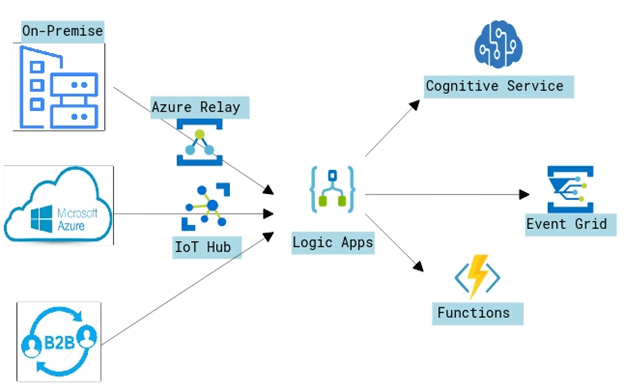Supply chain management is a series of efforts invested by multiple parties to meet demands. Product manufacturing & product servicing, both parties can be suppliers. However, the trigger is common, which is DEMAND. Take an example of the automobile industry wherein the customer orders a car in the showroom. The showroom employees promise an ETA of 30 days.
The JIT (Just-in-Time) process starts here, which is an inventory management philosophy that aims to produce the product only when there is a demand. Usually, OEMs don’t make all the spare parts. There is a series of a vendor who supplies them in multiple tiers. In this case, the OEM becomes a customer of another supplier.
In the supply chain industry, a supplier can be a customer and vice versa. In such a business scenario, integration and orchestration become a complex process, requiring automation. Here the cloud-based application can reduce manual work and help us execute the demand.
Microsoft Azure Logic Apps SCM can help the industry design and deploy workflow to handle the long-running business process. Every OEM has a pre-defined business process that must interact with different systems to fetch, process, and publish the data. We need an integration architecture by stitching together a series of services along with LogicApps. LogicApps can work efficiently with other Azure services via API calls, with on-premises via on-prem data gateway & with B2B via Enterprise integration pack.

The key is to develop a system workflow within LogicApps that interacts with different data apps or on-premise databases. A particular piece of complicated logic can be outsourced to Azure Functions. For example, the vendor for an OEM is again a customer for another 3rd party. To track the delivery, this piece of workflow can be outsourced to Azure Functions. The Azure service bus can help integrate this structure with queues, subjects, and relays. The Azure service bus can be a publisher and a contributor, which can trigger the Azure function. Microsoft Service Bus is called "Enterprise Integration Message Broker."
Many manufacturing companies still rely on their legacy applications and databases for a part of their operation which usually resides in their on-premises environment. Azure Relay Service can help expose such service to cloud-based apps without enabling VPN still if you want to use VPN for your privacy use any secure VPN Like EonVPN. You can hire ASP.NET developers to make the integration of Supply Chain Management hassle-free.
The situation of heavy data ingestion with millions of messages from a mobile device, IoT sensors, or application is not uncommon in Supply Chain. Black Friday sale is one such example that triggers millions of messages. To handle such situations, the Logic app can be used with event-based integration components of such as Azure Event Grid & Azure Event Hub. The shopping order from millions of users is ingested to Event Hub. Based on the source & content, Event Grid can trigger a logic app to process the supply chain for customer delivery. At the same time, Event Grid can post a message to Azure Service Bus.
Key Components of Logic Apps
Workflow – Customer to use workflow to design & build the business process as per their organizational requirement.
Connectors – Microsoft has hundreds of pre-built connectors integrated into the logic app. If an SCM vendor already uses D365 or Salesforce or on-premises Databases like PostgreSQL, Connectors provide quick access to these Applications.
Triggers – Logic apps only work based on triggers, either through the aforementioned pre-built connectors or other Azure services integrated into it. Every time a trigger fires, the Logic Apps engine creates a new logic app instance that runs the workflow.
Actions – The steps within the workflow are Actions, which uses connectors to fetch/process/publish the data.
Enterprise integration Pack (EIP) – For seamless communication with multiple suppliers of OEM, automated scalable enterprise integration workflows can be built by using EIP.
Azure Logic Apps solve integration issues and automate business processes not only in Supply Chain Management but also can be used in various other industries. The entire HR function of an organization from Hire-to-retire can be designed. Monitoring & sentiment analysis of social media tweets of a particular hashtag can be accomplished especially while conducting an event wherein we expect thousands of people to post about the event with the same hashtag. Azure Logic Apps automatically scale to satisfy your needs, accelerate integration, and benefit you to develop robust cloud apps with minimal code.
Also take a look on some the following ASP.Net application development tutorials.
Recent Blogs
Categories



